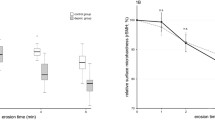Abstract
Demineralised bovine foetal enamel matrix was subjected to polyacrylamide gel “disc” electrophoresis at acid pH. This technique revealed a protein composition more complex than hitherto described with a minimum of six principal and twelve minor components. Sephadex G. 50 gel filtration chromatography at pH 3.0 and low ionic strength produced a partial separation of these components in accord with a fractionation based on molecular weight differences. Polyacrylamide electrophoresis of these column fractions both in the presence and absence of 5 M urea, showed that at acid pH the components seen in the acrylamide gels were not present as labile aggregates. These results are discussed in relation to current concepts of the matrix composition and its possible role in the calcification of enamel.
Résumé
De la matrice d'émail de bœuf déminéralisé est soumise à l'électrophorèse à gel de polyacrylamide, à pH acide. Une composition protéique beaucoup plus complexe que celle décrite jusqu'à présent est mise en évidence. Elle est constituée par 6 composés principaux et 12 composés mineurs. La chromatographie par filtration sur gel Sephadex G. 50, à pH 3.0 et sous force ionique faible, donne une séparation partielle de ces composants, qui concorde avec le fractionnement obtenu par différences de poids moléculaire. L'électrophorèse à polyacrylamide de ces fractions, avec et sans 5 M d'urée, montre qu'à pH acide, les composés isolés dans les gels d'acrylamide ne constituent pas des substances labiles. Ces résultats sont envisagés en fonction des théories actuelles concernant la composition matricielle et son rôle possible au cours de la calcification de l'émail.
Zusammenfassung
Die fetale Zahnschmelzmatrix von Rindern wurde demineralisiert und einer Polyacrylamid-Gel „Dise”-Elektrophorese bei saurem pH unterworfen. Diese Technik zeigte eine Proteinzusammensetzung, die komplexer ist als bisher beschrieben wurde, nämlich mit mindestens 6 Haupt- und 12 Nebenkomponenten. Sephadex G 50 Gel-Filtrations-Chromatographie bei einem pH von 3.0 und schwacher Ionenstärke ergab eine teilweise Trennung dieser Komponenten, in Übereinstimmung mit einer Fraktionierung, welche sich auf Unterschiede im Molekulargewicht stützt. Eine Polyacrylamid- Elektrophorese dieser Säulenfraktionen sowohl mit als auch ohne 5 M Harnstoff zeigte, daß bei saurem pH die Acrylamid-Gel sichtbaren Komponenten nicht als labile Aggregate vorhanden sind. Diese Resultate werden im Zusammenhang mit den aktuellen Begriffen über die Zusammensetzung der Matrix und ihrer möglichen Rolle bei der Verkalkung des Zahnschmelzes besprochen.
Similar content being viewed by others
References
Burgess, R. C., andC. Maclaren: Proteins in developing enamel. In: Tooth enamel: its composition, properties, and fundamental structure (M. V. Stack andR. W. Fearnhead, eds.), p. 74–82. Bristol: Wright 1965.
Chrambach, A., R. A. Reisfeld, M. Wyckoff, andJ. Zacchari: A procedure for rapid and sensitive staining of protein fractionated by polyacrylamide gel electrophoresis. Analyt. Biochem.20, 150–154 (1967).
Eastoe, J. E.: The amino acid composition of proteins from the oral tissues. II. The matrix proteins in dentine and enamel from developing human deciduous teeth. Arch. oral Biol.8, 633–652 (1963).
—: The chemical composition of bone and tooth. Advanc. Fluorine Res. and Dental Caries Prevention3, 5–16 (1965).
Glimcher, M. J., U. A. Friberg, andP. T. Levine: The isolation and amino acid composition of the enamel proteins of erupted bovine teeth. Biochem. J.93, 202–210 (1964).
—, andS. M. Krane: The identification of serine phosphate in enamel proteins. Biochim. biophys. Acta (Amst.)90, 477–483 (1964).
Katz, E. P., G. L. Mechanic, andM. J. Glimcher: The ultracentrifugal and free zone electrophoretic characterization of the neutral soluble proteins of embryonic bovine enamel. Biochim. biophys. Acta (Amst.)107, 471–484 (1965).
Levine, P. T., J. Seyer, J. Huddleston, andM. J. Glimcher: The comparative biochemistry of the matrix proteins of developing enamel. I. Amino acid composition. Arch. oral Biol.12, 407–410 (1967).
Mechanic, G. L., E. P. Katz, andM. J. Glimcher: The Sephadex gel filtration characteristics of the neutral soluble proteins of embryonic bovine enamel. Biochim. biophys. Acta (Amst.)133, 97–113 (1967).
Ornstein, L., andB. J. Davis: In: Dise electrophoresis. Reprinted by Distillation Products Industries, Rochester, New York 1962.
Reisfeld, R. A., U. J. Lewis, andD. E. Williams: Disk electrophoresis of basic proteins and peptides on polyacrylamide gels. Nature (Lond.)195, 281–283 (1962).
Tombs, M. P.: The interpretation of gel electrophoresis. Analyt. Biochem.13, 121–132 (1965).




